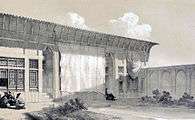East Azerbaijan Governance Palace
Coordinates: 38°04′43″N 46°17′52″E / 38.07861°N 46.29778°E

East-Azerbaijan Provincial Palace, Persian: کاخ استانداری آذربایجان شرقی, is the main office for Iran's East-Azerbaijan provincial governor in downtown of Tabriz. The history of the palace goes back to Safavid dynasty and Zand dynasty. Its early name was Aali Qapou. The original construction of the palace was supervised by Najaf Qoli Khan for the Safavid kings while Tabriz used to be Capital of Iran. In Qajar dynasty era while Tabriz was residence for crown prince of Iran, Aali Qapu was the palace for the prince. During Qjar prince residence in palace, Naser al-Din Shah, he ordered to change its name to Shams ol-Emareh. At this time the palace was reconstructed and repaired. After Iranian Constitutional Revolution the palace is used as provincial governorship office which is simply called Provincial capitol (Persian: کاخ استانداری).
Main parts of original building were destroyed in a fire in 1933 which followed later on by a major flood. Remaining parts of the original palace were destroyed entirely by the East Azerbaijan governor at the time, Ali Mansur, and a newer building was constructed. The new building which has survived up to now is mostly constructed in Mansur's time in Tabriz as governor.[1]
Part of the state building is open for public visitors.[2]
History
Aali Qapu (1500-1800)
The original building of the Aali Qapu palace was built in the late Safavid era, when Tabriz was capital of the Iranian Empire. This building was built in competition with Ottoman Empire, while two states were sworn enemies of each other. In later years during Afsharid dynasty and Zand dynasty, the palace was used as the palace for local governor of Azerbaijan.
Shams ol Emareh (1800-1933)
Within the start of Qajar dynasty and with dominance of Tabriz role in Iranian politics, city was chosen as the residence of the Crown Prince. In this period, the palace was the office for the crown prince. A newer part called Haram-khaneh (residence) was constructed next to the palace as the residence of the Prince as well. In period of Naser al-Din Mirza residence, the building was renamed to Shams ol-Emareh after Shams ol-Emareh building in Golestan Palace in Tehran. In Qajar era many ceremonies of Royal family were held in this building. This includes marriage ceremony of Qajar Prince Etezad ol-Saltaneh.
East Azerbaijan Provincial Palace (1933-)
After the Qajar dynasty, in the Pahlavi era, Tabriz lost its traditional dominant role in Iranian politics. With this, the palace also lost its traditional royal importance. In Pahlavi's era, the building was used as the office of the East Azerbaijan governor. In 1933 during Adib-ol-Saltaneh Samei (in Persian: ادیب السلطنه سمیعی), large parts of the building were ruined in a fire. Many people were blamed for negligence in the protection of the palace. In 1934 some other parts of the building were destroyed in a flood. In 1946, Governor Ali Mansur (in Persian: علی منصور), the rest of the remaining parts of the palace were destroyed and a new marble building was constructed instead, which has served as the office of the provincial governor till now. In 1969, the Haram-khaneh building was also destroyed and the city's governor office was built in its place. Local people criticized governors for their ignorance and the destruction of the city's heritages.[3]
Museum
In 2013 a museum titled East Azerbaijan Governorship was established in the building containing the photos of Azerbaijan governors, important documents, memorials and gifts for the governors.
War Heroes Statues
In front of the Provincial Palace there are statues of six Iranian Azerbaijani war heroes who were killed in the 1980s during Iran-Iraq war. These include statue of Javad Fakoori, and Mehdi Bakeri.
-

Aali Qapu's main building.
-

Wedding ceremony of Etezad-ol-Saltaneh.
-

Haramkhane and green house of Aali-Qapu, in a royal ceremony.
-

Hail ceremony to Prince Mozaffar Mirza in Haram khana part of Aali Qapu late on 1800s.
-

Haramkhane, sketched by Eugene Flandin, 1841.
-

A photo of the State Palace after reconstruction.
Etymology
The original name of the building, i.e., Aali Qapu is made of two parts: 'Aali (عالی) which is from Arabic and means 'high, sublime' and Qapu (قاپو) which is from Turkic and means 'door'. This name was also used in the Safavid era for a building in Isfahan.